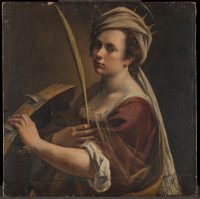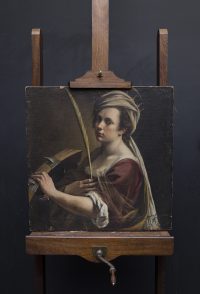Baroque master Artemisia Gentileschi would have been 425 years old today. The first woman granted membership to Florence’s Accademia del Disegno, she was famous in her time and counted the crowned heads of Europe among her clientele. Her striking works, often featuring illustrious women from history and the Bible, have become icons of female representation during a time when women were largely excluded from the painterly ranks.
Her private life has been inextricably woven into her oeuvre. She used herself as a model frequently — a number of self-portraits of her as saints, artists and allegories, particularly from her Florentine period, have survived — and her powerful female protagonists have been adopted as symbols of empowerment in the wake of her rape and the subsequent trial of the perpetrator, her art teacher Agostino Tassi. We know from the incredible survival of the transcripts that she stood up for herself at the 1611 trial even under torture. (Rape accusers in the Papal States were subjected to the thumbscrews, among other torture techniques, to ensure their veracity.) For many years she was treated by art historians something of a curiosity, a successful woman artist with a tragic personal history that seemed to be reflected in works like Judith Slaying Holofernes.
 The worm has turned for Artemisia, and the understanding of her art on its own terms rather than as mere Caravaggista works or as fodder for five-cent psychological interpretations has led to a massive uptake in interest and demand from museums and collectors. In 2014, a rediscovered Mary Magdalene in Ecstasy broke the sale record for an Artemisia Gentileschi painting when it sold for €865,500 (ca. $1,175,000). In December of 2017, another rediscovered work, Self Portrait as Saint Catherine of Alexandria (ca. 1615-1617), went up for auction in Paris. It broke the new record even more dramatically than the 2014 sale had broken the 1998 record, selling for €2,360,600 ($2,775,000).
The worm has turned for Artemisia, and the understanding of her art on its own terms rather than as mere Caravaggista works or as fodder for five-cent psychological interpretations has led to a massive uptake in interest and demand from museums and collectors. In 2014, a rediscovered Mary Magdalene in Ecstasy broke the sale record for an Artemisia Gentileschi painting when it sold for €865,500 (ca. $1,175,000). In December of 2017, another rediscovered work, Self Portrait as Saint Catherine of Alexandria (ca. 1615-1617), went up for auction in Paris. It broke the new record even more dramatically than the 2014 sale had broken the 1998 record, selling for €2,360,600 ($2,775,000).
Well, we can kiss that record goodbye too, because less than a year later, the dealer who acquired Self Portrait as Saint Catherine of Alexandria has sold it to London’s National Gallery for £3.6 million ($4,784,000). Paying this eye-watering price was made possible by donations from the American Friends of the National Gallery, the National Gallery Trust, Art Fund, Lord and Lady Sassoon, Lady Getty, Hannah Rothschild CBE, and others who prefer to remain anonymous.
It is the first work by a female artist bought by the National Gallery in almost 30 years, and is only the 21st painting by a woman to join the 2,300 works in the NG’s permanent collection. It’s also just the third easel painting by Artemisia Gentileschi in England.
 Self Portrait as Saint Catherine of Alexandria depicts the saint turned toward the viewer. The figure is identifiable as the saint because of the spiked wheel on which she rests her left hand, the means by which Saint Catherine was supposed to be martyred in the 4th century by order of the Emperor Maxentius only for it to break the moment she touched it. He ordered her beheaded instead and that one did the trick. Unique for her time, Artemisia crops the scene very tightly around the upper body of the saint. This is something you see repeatedly in her portraits of herself as other people.
Self Portrait as Saint Catherine of Alexandria depicts the saint turned toward the viewer. The figure is identifiable as the saint because of the spiked wheel on which she rests her left hand, the means by which Saint Catherine was supposed to be martyred in the 4th century by order of the Emperor Maxentius only for it to break the moment she touched it. He ordered her beheaded instead and that one did the trick. Unique for her time, Artemisia crops the scene very tightly around the upper body of the saint. This is something you see repeatedly in her portraits of herself as other people.
Letizia Treves, The James and Sarah Sassoon Curator of Later Italian, Spanish, and French 17th-century paintings at the National Gallery say:
“Artemisia is without question one of the most celebrated painters of her time, and we have long wished to acquire a painting by her for the national collection. The fact that this is a self-portrait adds enormously to the painting’s appeal and art historical significance. We are fortunate to have one of the strongest collections of Italian Baroque paintings but, with the exception of Caravaggio, no Italian artist of the 17th century surpasses Artemisia in terms of fame and popular appeal. Following conservation treatment and reframing Self Portrait as Saint Catherine of Alexandria will find a natural home alongside other works by Italian Baroque painters, including Caravaggio and Artemisia’s father Orazio Gentileschi.”